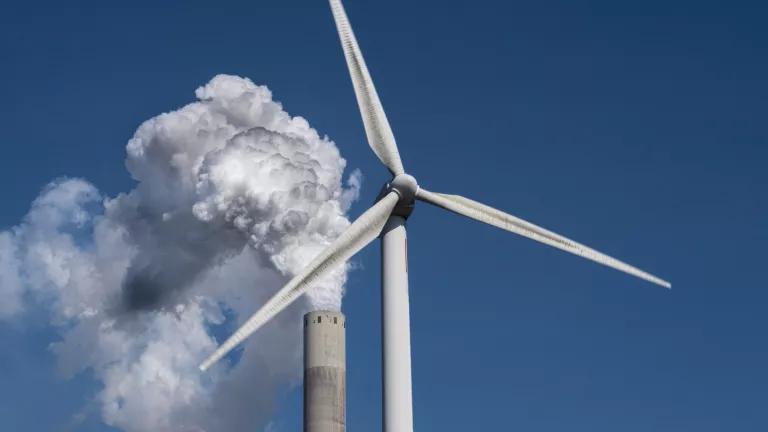Cleaning Up Power Plants Is Key to Our 2030 Climate Target
NRDC analysis shows we can cut power plant carbon pollution 85 percent by 2030 as part of a national plan to cut heat-trapping emissions in half.

iStock
Cutting carbon pollution from the nation’s power plants plays a prominent part in the ambitious climate target that President Biden announced at today’s Leaders Summit on Climate.
The president’s plan, elaborated in a new U.S. Nationally Determined Contribution (NDC), commits the United States to cutting overall climate pollution by 50-52 percent below 2005 levels by 2030, and to reaching net-zero emissions by 2050. NRDC analysis shows that target is within reach with the right combination of standards and investments under existing law and new legislation.
Cleaning up America’s power plants is essential to meeting the president’s 2030 climate target. And beyond their massive contribution to the climate crisis, power plants also cause tens of thousands of deaths and hundreds of thousands of illnesses. Power plants emitted 1.6 billion tons of CO2 in 2019—25 percent of U.S. heat-trapping emissions, second only to motor vehicles. They also released nearly a million tons of sulfur dioxide and nearly 900,000 tons of nitrogen oxides, as well as mercury and dozens of other hazardous air pollutants. And they created more than 500,000 tons of toxic water pollutants and tens of millions of tons of coal ash.
The harm from power plant pollution affects all Americans, especially those living in overburdened and disadvantaged communities. With an ambitious, multi-pollutant power sector strategy, we can achieve massive climate and public health benefits.
Cleaning up the power sector is also the key to cleaning up other sectors. Electrifying buildings, vehicles, and industry is the most effective way to eliminate their carbon pollution, as well as other pollutants. This is a major growth opportunity for the power industry—if it cleans up its own emissions.
We have the technologies and tools we need. NRDC’s analysis shows that with the right policies supporting market trends, we can reduce 2030 power sector carbon pollution by 85 percent from 2005 peak levels. Because power sector carbon reductions are the most cost-effective, and because they bring such huge climate and public health benefits, an 85 percent reduction from power plants is essential to meeting the president’s overall national carbon reduction commitment for 2030.
We can meet that 85 percent reduction by simultaneously pursuing both regulatory and legislative pathways to clean up power plants. As the new U.S. commitment states: “Policies that contribute to emission reductions pathways consistent with the NDC include incentives and standards to reduce pollution.”
New Legislation. President Biden has set a goal of achieving 100 percent carbon pollution-free electricity by 2035, and in his American Jobs Plan he has called on Congress to enact a Clean Electricity Standard. The American Jobs Plan and the companion Made in America Tax Plan provide for critical additional investments and tax incentives to build more wind, solar, storage, and other clean energy technologies, and to modernize the electric transmission grid to bring power from regions blessed with clean resources to places where most power is consumed.
A clean energy standard requires the electric utilities that deliver your power to ramp up the share of clean energy in the mix of power that they generate or purchase. It is a popular policy and a cost-effective means of achieving our carbon goals. Our modeling has shown that the clean energy standard bill introduced by Rep. DeGette last year would avoid some 3,200-7,280 premature deaths per year beyond business as usual, by also reducing power plants’ SO2 and NOx pollution.
NRDC is working hard to enact the American Jobs Plan, with a strong clean energy standard and its other vital clean energy investments, this year. These proposals from the Biden administration are critical to achieve our climate goals while creating millions of good jobs and investing in communities that have been overburdened by pollution and that need help to participate in the clean energy economy of the future.
Action under existing law. It is also critical that EPA act simultaneously under existing law. NRDC and other environmental organizations recently called on the president to pursue an ambitious multi-pollutant power sector strategy under the Clean Air Act and other laws, with a clear and aggressive action schedule.
The president has already directed EPA to review all regulations undermined by the previous administration and specifically to shore up and strengthen standards for power plant emissions of mercury and other toxic air pollutants.
And EPA must also write a new standard for America’s existing power plants under Clean Air Act section 111, following a landmark court decision striking down the prior administration’s do-nothing carbon pollution standard. Administrator Michael Regan promised to write a new carbon pollution standard on a clean slate. Now, under the president’s new climate action plan, EPA needs to set a clear timetable to get this done.
The Biden administration’s power sector goals are achievable, as the new NDC states, through “multiple cost-effective technology and investment pathways.” Those include actions under existing laws and new standards and investments from Congress. That’s a winning combination to create jobs, promote equity, improve people’s health and move us quickly to the clean energy economy of the future.




